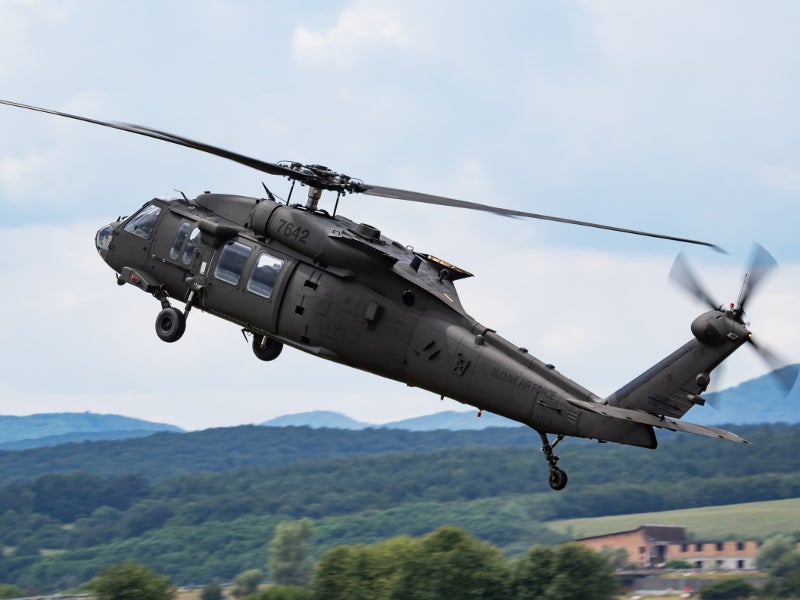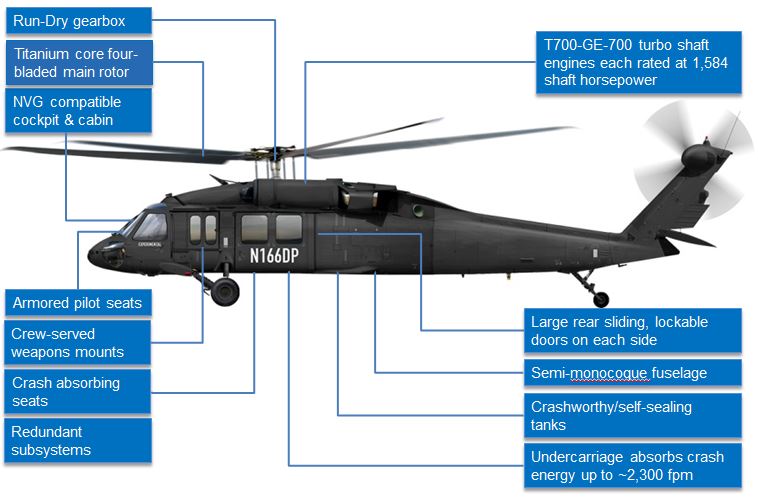Flying High: UH 60 Helicopter Security Protocols You Need To Know
Wiki Article
Recognizing the Mechanics and Engineering Behind Uh 60 Helicopters
The UH-60 helicopter, generally recognized as the Black Hawk, stands as a peak of modern-day rotorcraft technology, embodying a blend of robust design and intricate mechanics. As we peel back the layers of the UH-60's design, a globe of intricate systems and meticulous engineering comes to light.Background of UH-60 Helicopters
The history of UH-60 helicopters traces back to the late 1970s when the USA Military looked for a advanced and functional energy helicopter to replace its aging fleet. In response to this demand, the Sikorsky Airplane Company developed the UH-60 Black Hawk helicopter. Presented in 1979, the UH-60 promptly ended up being a staple in military procedures because of its outstanding capabilities.
The UH-60 was made to master a range of missions, consisting of troop transportation, clinical emptying, electronic war, and unique operations. Its capacity to adjust to different roles made it a beneficial property to the united state Army and various other army forces all over the world
Throughout the years, the UH-60 platform has actually undergone numerous upgrades and variations to boost its performance and maintain speed with evolving objective requirements. These helicopters have seen comprehensive solution in disputes such as the Gulf Battle, Afghanistan, and Iraq, showcasing their dependability and versatility in varied operational environments. The UH-60's abundant history is a testimony to its long-lasting tradition as a leading utility helicopter.

Engine and Power Solutions
Using innovative propulsion innovation, UH-60 helicopters are furnished with sophisticated engine and power systems to make sure ideal performance and reliability in a variety of functional circumstances. The UH-60, frequently called the Black Hawk, is powered by two General Electric T700-GE-701D engines, each capable of delivering up to 1,940 shaft horsepower. These turboshaft engines offer the necessary drive for the helicopter to lug out its objectives efficiently, consisting of army transport, clinical emptying, and combat assistance.
Rotor System and Aerodynamics
Exactly how do the rotor system and aerodynamics of UH-60 helicopters add to their operational efficiency and trip capacities? The blades system of the UH-60 helicopter plays an important duty in giving lift and propulsion. The UH-60 includes a four-bladed, totally articulated rotor system that permits high maneuverability and stability during trip. This layout makes it possible for the helicopter to execute a wide variety of objectives, from transport and medical evacuation to battle procedures.Aerodynamics additionally play a crucial role in the efficiency of UH-60 helicopters. The structured fuselage and rotor blade layout minimize drag, allowing the helicopter to achieve greater speeds and better gas effectiveness. The wind resistant style of the UH-60 likewise adds to its ability to run in diverse environmental conditions, consisting of hot temperature levels and high altitudes.
Avionics and Trip Control Solution

In its elaborate control with the rotor system and aerodynamics of UH-60 helicopters, the avionics and trip control systems form a vital network of technologies shaping the aircraft's functional capacities. In the UH-60, these systems consist of electronic screens, communication radios, GPS navigating, weather company website radar, and autopilot systems.
The flight control systems of the UH-60 are accountable for converting the pilot's inputs into the suitable changes to the blades system, making certain secure flight and ability to move. These systems include hydraulic actuators, servos, and computer systems that interact to control the main and tail rotors, along with other flight control surface areas. By precisely handling the helicopter's flight dynamics, these systems allow pilots to perform a vast variety of objectives, from transport and search-and-rescue to fight procedures, with precision and confidence.
Duty and Applications in Air Travel
Avionics systems in UH-60 helicopters incorporate an array of digital systems that help in navigating, interaction, monitoring, and regulating various airplane features. These systems consist of digital display screens, auto-pilot systems, communication radios, GPS navigation tools, and weather radar. Furthermore, these systems include security features such as autopilot settings, surface awareness cautioning systems, and stability augmentation systems to improve the general safety and functional capabilities of the UH-60 helicopters in different objectives, consisting of troop transportation, medical evacuation, search and rescue, and aerial firefighting.Conclusion
In conclusion, the UH-60 helicopter is a flexible aircraft with a rich history and progressed engineering. Its engine and power systems, blades system, the rules of aerodynamics, avionics, and trip control systems all work together to make it a trustworthy and effective maker. The UH-60's function and applications in aeronautics are large, varying from army operations to browse and save objectives. Its continued development and usage show its importance in the field of air travel (uh 60).In its elaborate control with the rotor system and the rules of aerodynamics of UH-60 helicopters, the avionics and trip control systems form a critical network of innovations shaping the airplane's operational capabilities.The flight control systems of the UH-60 are liable for converting the pilot's inputs into the appropriate adjustments to the blades system, making certain stable flight and ability to move. Avionics systems in UH-60 helicopters include an array of digital systems that help in navigation, interaction, surveillance, and managing various airplane functions. Furthermore, these systems include safety features such as auto-pilot modes, surface awareness cautioning systems, and stability augmentation systems to improve the general safety and security and functional abilities of the UH-60 helicopters in various goals, including troop transportation, clinical discharge, search read more and rescue, and airborne firefighting.
Its engine and power systems, blades system, the rules of aerodynamics, avionics, and trip control systems all work together to make it a efficient and reliable this content device.
Report this wiki page